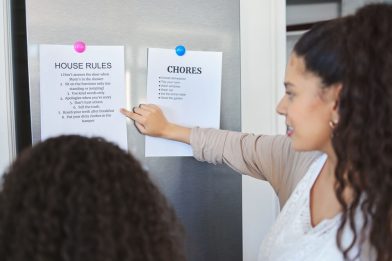All about baby teeth: when and how do they fall out?
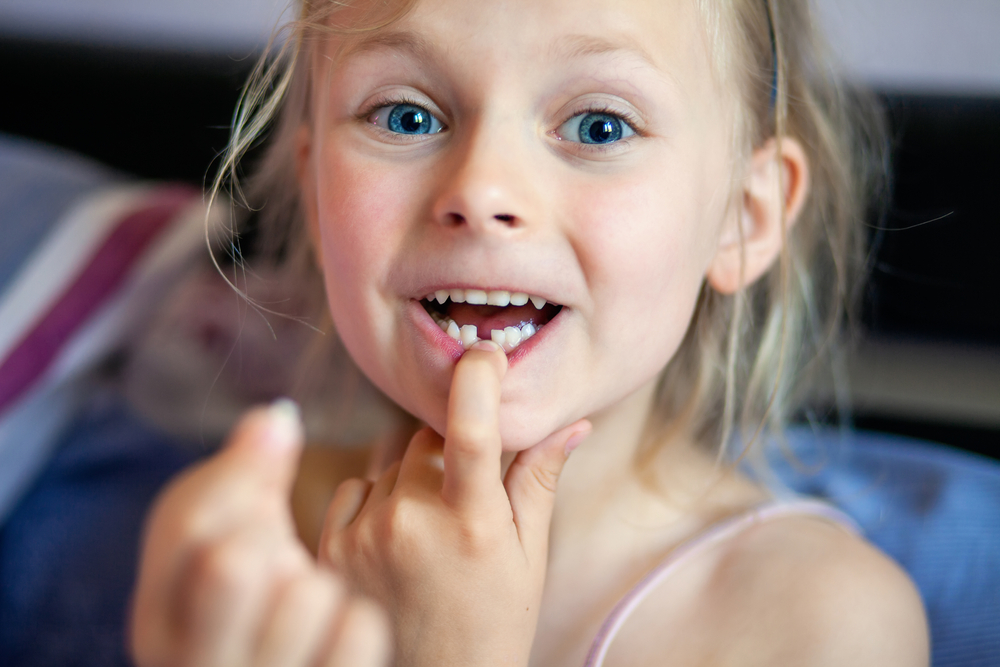
Which teeth replace baby teeth ones in children? At what age do baby teeth begin to fall out and can they remain in the jaw until an older age? In this article, we will also discuss the child’s change in bite and the potential problems associated with it.
To begin with, stop overprotecting the child and provide reasonable freedom to the developing individual. However, in order not to worry and to continue ensuring safety to your child, download the “Findmykids” app from AppStore and GooglePlay. With it, you will always know where your child is, what they are doing, and how things are going at school.
Contents:
- What are deciduous teeth or baby teeth?
- How and when do baby teeth get replaced?
- Temporal deviations and issues during the transitional phase
- Can a baby tooth be taken out on your own?
- What should not be done?
- Where to put baby teeth after they fall out?
- Useful tips for parents
What are deciduous teeth or baby teeth?
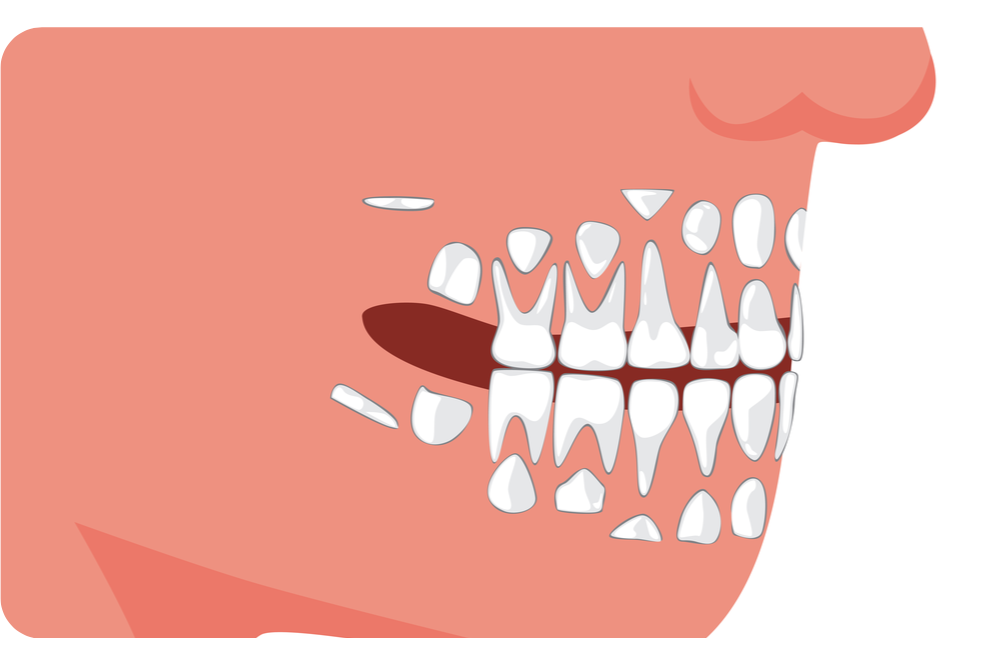
Prostock-studio/Shutterstock.com
A child may think that baby teeth are only needed for the tooth fairy to build her castle from them. However, adults should know the truth. When a child is very little, their head, and therefore their jaw, is proportionally small. If the child had their permanent molars instead of their baby teeth right away, they would not fit into the mouth due to their size or quantity. Therefore, nature gave us a temporary solution for our first ten years of life.
There are 20 milk teeth in total (10 each on the upper and the lower jaw). There are central and lateral incisors, canines, and molars. Usually, a child has all of them at the age of 3-3.5 years old.
Deciduous teeth differ from permanent ones not only in size, but also in their structure. The enamel of deciduous teeth is about 2 times thinner, it is also not so rich in minerals. Therefore, the child needs to take care of their oral hygiene as caries develop very quickly on baby teeth. This is due to the fact that the baby’s teeth’ enamel is not only thin, but it also has a layer under it called dentin that causes caries to develop into pulpitis very swiftly. Baby teeth have both nerves and roots, however, they are shorter than permanent ones. They even start to “dissolve” gradually during the bite change. This is the reason why the so-called ‘milk’ teeth begin to wobble and fall out.
If baby teeth are not treated and not taken care of, the child may develop gum inflammation which may lead to an illness or even the destruction of the root of the permanent tooth. Do not ignore the signs of tooth decay!
How and when do baby teeth get replaced?

Prostock-studio/Shutterstock.com
Loss of baby teeth begins at the age of about 6-7 years of age and usually lasts up to 10-12 years old. Note that girls let go with their deciduous teeth earlier than boys and that their teeth replacement process is quicker.
A number of factors will indicate parents of the imminent change of baby teeth in a child. Due to the growth of the jaw, the distance between the incisors will increase, and the rudiments of molars will become visible under the milk teeth, and in turn, deciduous teeth will be loosened.
On average, the age of teeth replacement corresponds to the age groups presented in the following table:
The sequence of the losing deciduous teeth
| Age | Teeth that fall out |
| 6-7 years old | Central incisors |
| 7-8 years old | Lateral incisors |
| 9-11 years old | First molars |
| 10-12 years old | Canines and second molars |
Please note that the new tooth may not be in a hurry to get replaced by the lost one. If a couple of weeks or even more than a month has passed, and there are still no permanent teeth in sight, do not panic. Note that there are more permanent teeth, hence some will take their place without replacing their predecessors. For example, the first permanent molars themselves at the age of 5-7, not replacing any other teeth, so do not get confused.
The growth of permanent teeth
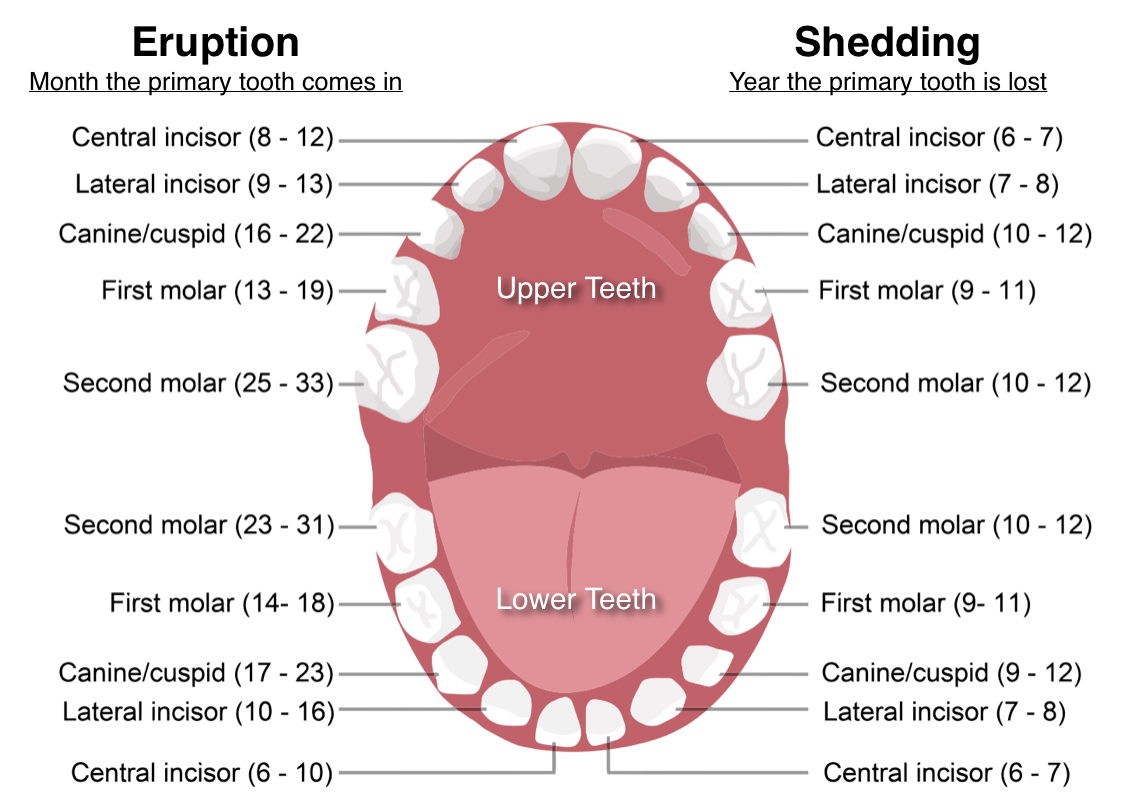
Prostock-studio/Shutterstock.com
The table below will allow you to get a precise idea of the process of teeth replacement:
| Permanent tooth | Age of appearance | Which deciduous tooth is replaced |
| Central incisors | 6-8 years old | Central incisors |
| Lateral incisors | 7-9 years old | Lateral incisors |
| Canines | 10-13 years old | Canines |
| First premolars | 9-12 years old | First molar |
| Second premolars | 10-13 years old | Second molar |
| First molars | 5-7 years old | Do not replace deciduous teeth |
| Second molars | 11-14 years old | Do not replace deciduous teeth |
| Third molars | 17-25 years old | Do not replace deciduous teeth |
If not taking into account the third molars (which are also called wisdom teeth), girls will have a fully formed jaw by the age of 11-13, and boys, by the age of 13-14 years old.
It is important to understand that the baby tooth may not change. For example, if the rudiment of a molar tooth has died, then there is no need for the deciduous tooth to fall out. Some people may still have baby teeth even at the age of 30. Therefore, if the baby tooth does not fall out, you should not make efforts to loosen it or try to pull it out at home. We will look at other problems associated with the teeth replacement phase in this article.
Temporal deviations and issues during the transitional phase
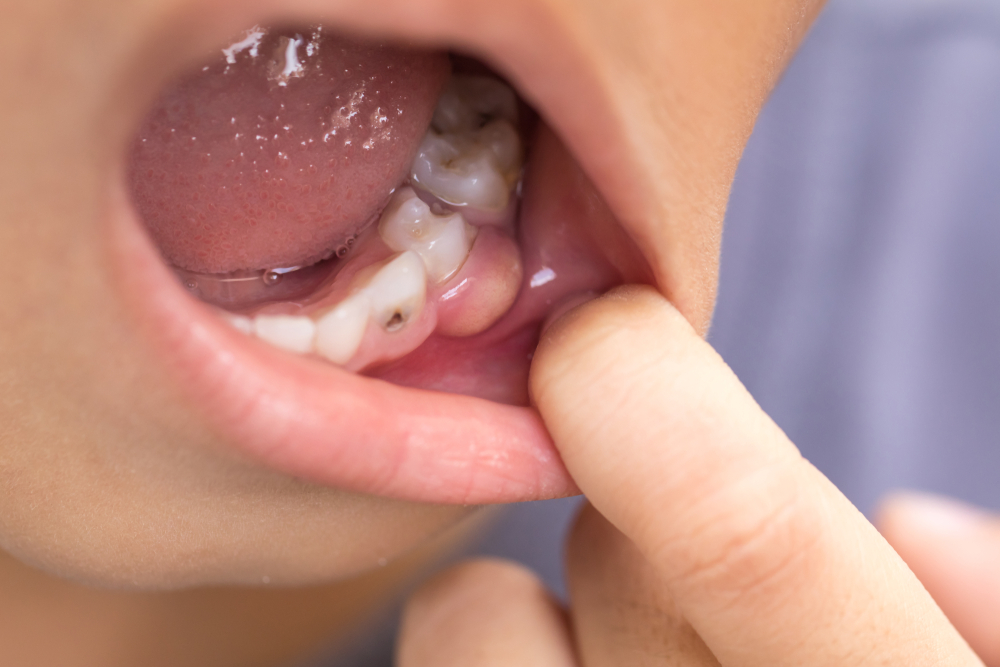
Prostock-studio/Shutterstock.com
A problem with the loss of baby teeth and the growth of permanent ones happens to at least 10% of children. Fortunately, dentists are ready to correct the bite at the stage of growth, to extract the extra teeth and even to put an implant, in the event where the permanent tooth is not expected to grow.
Let’s consider the main deviations that can cause issues:
“The shark’s mouth”
Sometimes milk teeth do not have time to fall out, and permanent teeth start growing in a second row. The “shark’s mouth” is not necessarily a good sign. You will need to go to the dentist as soon as possible and have them remove the unnecessary baby teeth, otherwise, this can negatively affect the child’s bite.
The wrong timing on teeth replacement
If the first milk teeth begin to fall out of the baby’s mouth before the age of 5 years old or after the age of 8 years old, then this is a deviation from the norm, which means that you would need to understand the reason for it. It can be caused by trauma, caries, bad ecology, poor nutrition, recurring family problems with the bite or other hereditary factors, such as various infectious diseases, hormonal problems (for example, thyroid disease), as well as diseases that put the child at risk for underdevelopment and delay the formation of a permanent bite, such as diabetes, leukemia, immunodeficiency and others.
The permanent tooth does not grow as a replacement of the lost baby tooth
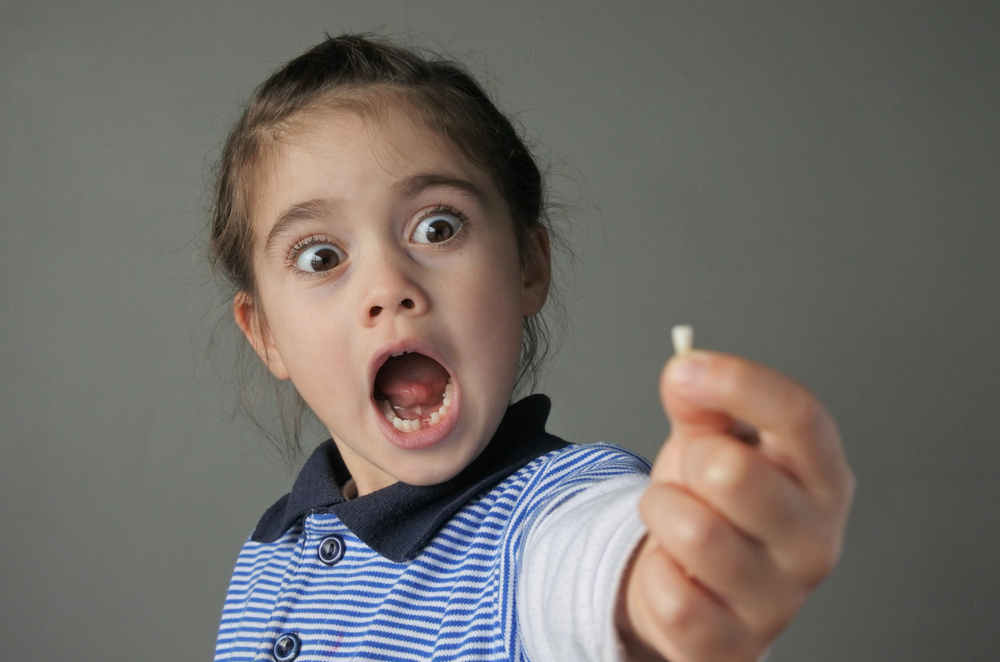
Prostock-studio/Shutterstock.com
There is no need to panic, however, it is worth consulting a specialist. For example, if the permanent tooth is growing, although the baby tooth one fell out a long time ago, the cause cannot be determined by simply looking at it, but with the use of an X-ray. If there is no tooth root in the picture, this is called adentia.
The problem of the tooth simply having nothing to grow from, is extremely rare and it requires the assistance of a dental prosthetist.
In case of retention, the root of the new tooth is present, however, it is pointing in the wrong direction or is located deeply in the gum. In this situation, you would have to wait for the tooth to grow. This problem is frequent for the third lower molars, as well as the upper incisors and canines.
During impaction, the tooth cannot come out due to being too close to adjacent teeth. Here, too, you will not be able to avoid seeking the help of a professional.
We also suggest going to the doctor if the following is taking place:
- permanent teeth grow darkened or crooked;
- the sequence of tooth loss and growth differs significantly from the information presented above;
- the child has sore gum and a swollen cheek;
- the baby tooth is affected by caries;
- the tooth has fallen out, however, the blood is not stopping for more than an hour (the blood is not to be confused with the lymph).
Can a baby tooth be taken out on your own?
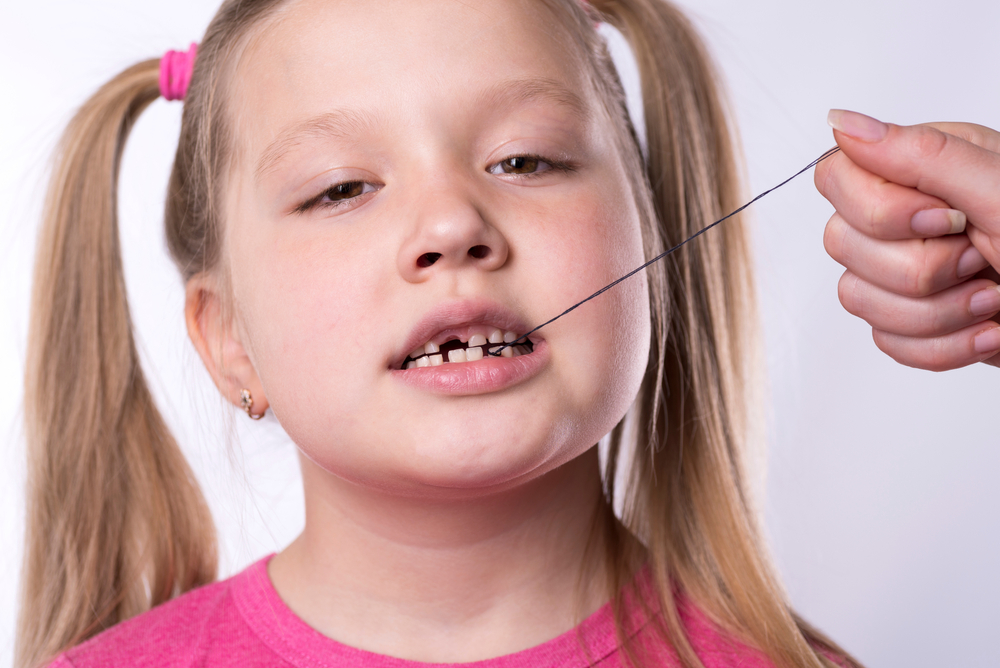
Prostock-studio/Shutterstock.com
At home, you can remove a milk tooth only if it is well loosened, meaning that it moves freely in the gum.
It is important to make sure that the child does not have a cold: coughing, sneezing, runny nose are signals to stop the home extraction of a baby tooth. Examine the child’s mouth, and if there is swelling or bleeding of the gums, your manipulations may lead to gum infections. In this situation, it would be better to see a dentist.
If you have decided to remove the baby tooth, it is better not to experiment with tying it to the door handle, according to the principle used in the era of your grandparents.
The best way is to grab the tooth with a cotton pad soaked in alcohol and pull it until it comes out. The tooth can also be wrapped with sterile thread and pulled in a strictly perpendicular direction to the jaw.
After the procedure has been successfully completed, the child would need to rinse their mouth, the parent should inspect to see if there are any fragments of the tooth left (if the tooth is broken and something remains, you will need to seek the assistance of a dentist). A sterile cotton round is placed on the gum for 20 minutes: the child must press it with their teeth to stop the bleeding. Make sure that the child does not drink or eat for a couple of hours after the tooth extraction.
If the tooth falls out on its own, put a cotton swab in the root and do not let the child eat or drink for some time.
What should not be done?
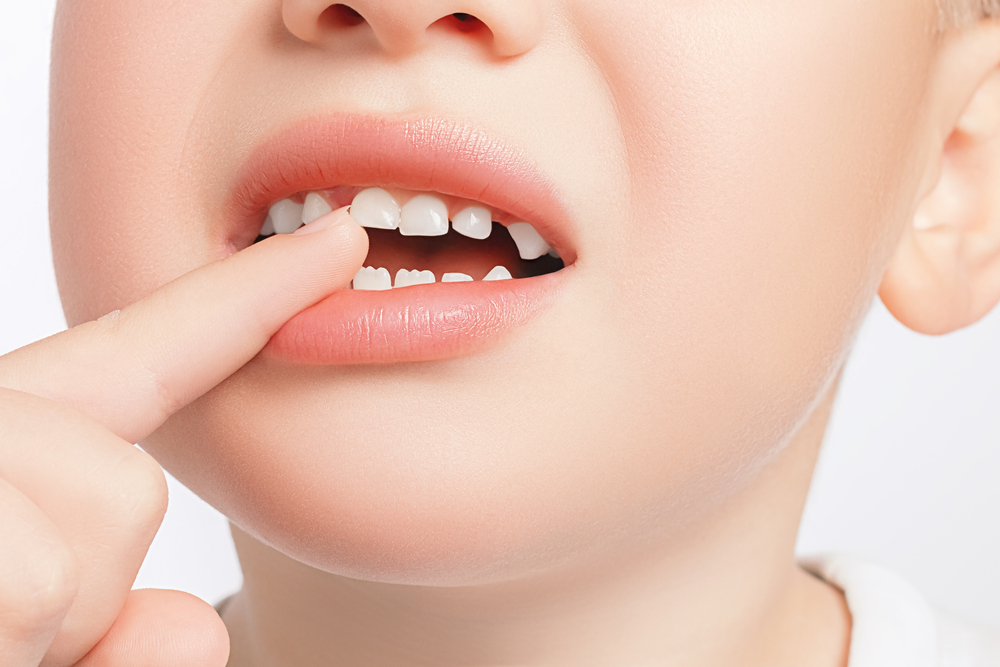
Prostock-studio/Shutterstock.com
The following rules will allow you to avoid issues with the bite, as well as the appearance of various defects:
- do not allow the child to loosen their teeth if they are not about to fall out yet if they are firm in their gums;
- tell your child not to touch a loose tooth with dirty hands (and, of course, they should not touch the place where the tooth just fell out);
- do not give your child a lot of solid foods during the bite change as they are more prone to breaking baby teeth that are more fragile;
- do not pour alcohol over the gum to disinfect it, after the tooth has come out;
- do not be ironic over the temporary absence of teeth of the child.
Where to put baby teeth after they fall out?
The first tooth can be kept as a keepsake or given to the child to put in a box with children’s valuables. If sentiments do not prevail in your family, then the tooth can be thrown out.
In many families, the tooth is placed under a pillow so that it can be taken in exchange for a coin or a small gift from the tooth fairy. This tradition comes from Europe. According to the tale, the fairy builds a castle from children’s teeth, and this castle becomes a place of good dreams.
However, in some families, there is also a tradition to give a dropped tooth to the ‘mouse’, which can also thank you with a gift. The tooth would be thrown on the ground or hid behind the stove. Nowadays, such a tradition is more suitable for families living in private houses. Nevertheless, you can always take any magical character that your child likes and come up with a story of where the baby’s tooth will go.
Interesting fact: there are both stem and progenitor cells in milk teeth. Scientists believe that in the future, with the development of science and technology, milk teeth can be used for the benefit of their owners, for example, for the treatment of serious diseases. However, in order to preserve the cells in the tooth, special storage conditions are necessary, which, unfortunately, cannot be recreated at home.
Useful tips for parents

Prostock-studio/Shutterstock.com
It is difficult to keep track of what teeth change in children and when does that happen, especially if there are several children with a small age difference in the family.
We advise you to create a table to mark the teeth down. You will mark the lost baby teeth and the permanent ones that have appeared, together with your child. You will then be sure not to get confused. Do not forget to mark the dates: this way, you will closely monitor the timing of the bite change.
Talk to your child about the upcoming change from baby teeth to permanent ones in advance. This way, they will not be scared when one of the teeth begins to wobble.
From the moment baby teeth appear, monitor your child’s oral hygiene. Teach them to thoroughly brush their teeth and rinse them after eating at the age of 2-3 years old. It is better to use no water for these purposes, but rather a special herbal tonic or homemade chamomile infusion.
Adopt a tradition of examining your child’s teeth: this way you will be able to watch out for caries if it appears.
During the period of teeth replacement, it would be beneficial to increase the amount of calcium-containing foods in the child’s diet. And when permanent teeth begin to appear, try to have them eat soft foods (for example, pureed soups).
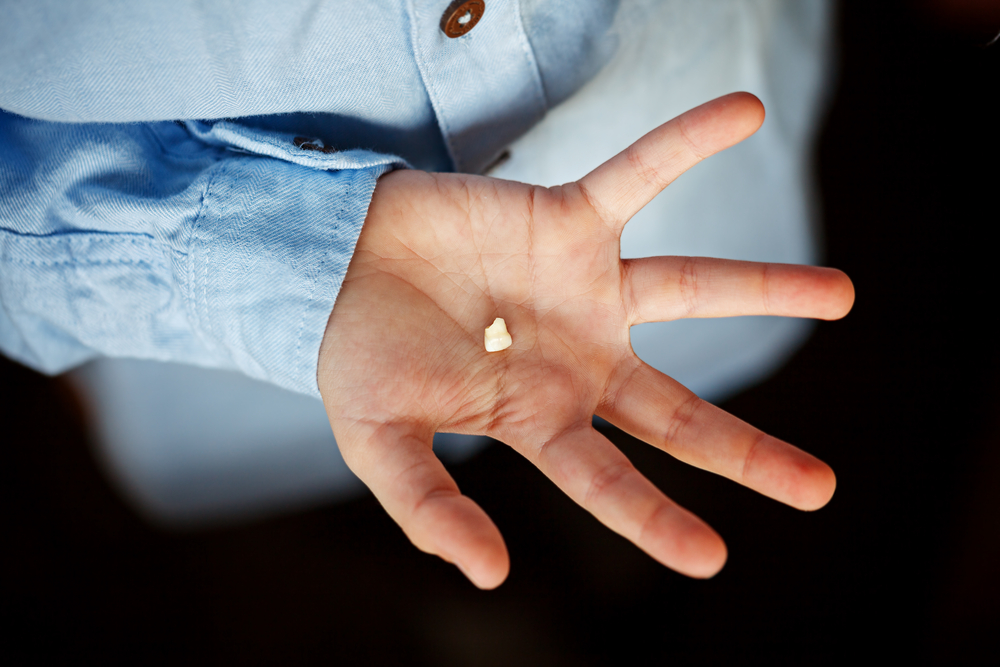
Prostock-studio/Shutterstock.com
To conclude this article, we can note that childrens’ teeth replacement is a natural process that should not scare either the baby or the parent. Talk with your child about this, prepare a table on which you will mark the changed teeth together, however, do not rush the process. If you encounter any difficulties, discuss them with your doctor.
Note that it will take years to fully update the bite. It is important that the child does not try to get rid of milk teeth on their own in the event when their friends from kindergarten or school have started losing teeth earlier than them.
Heredity matters. If the parents have an incorrect bite (or had such a bite in childhood), it is better to track the growth of permanent teeth and to correct their position right away. The older a person gets, the longer it will then take to resolve this problem.
Milk teeth are less sensitive than permanent ones when they are treated or pulled out. However, the child is also more eager to experience stronger pain and to be scared. Let the appointments with dentists be as comfortable as possible. In the future, your son or daughter will not be afraid to consult a doctor for a preventive examination on a regular basis, which means that they would have a great-looking smile for a much longer time.
Проверьте электронный ящик
















